Korean Candied Sweet Potato (Goguma Mattang)
Goguma mattang is Korean candied sweet potato covered in a hard caramelized sugar candy. With a crunchy exterior and a soft, fluffy interior, this Korean treat is a perfect sweet snack for the fall and winter seasons.
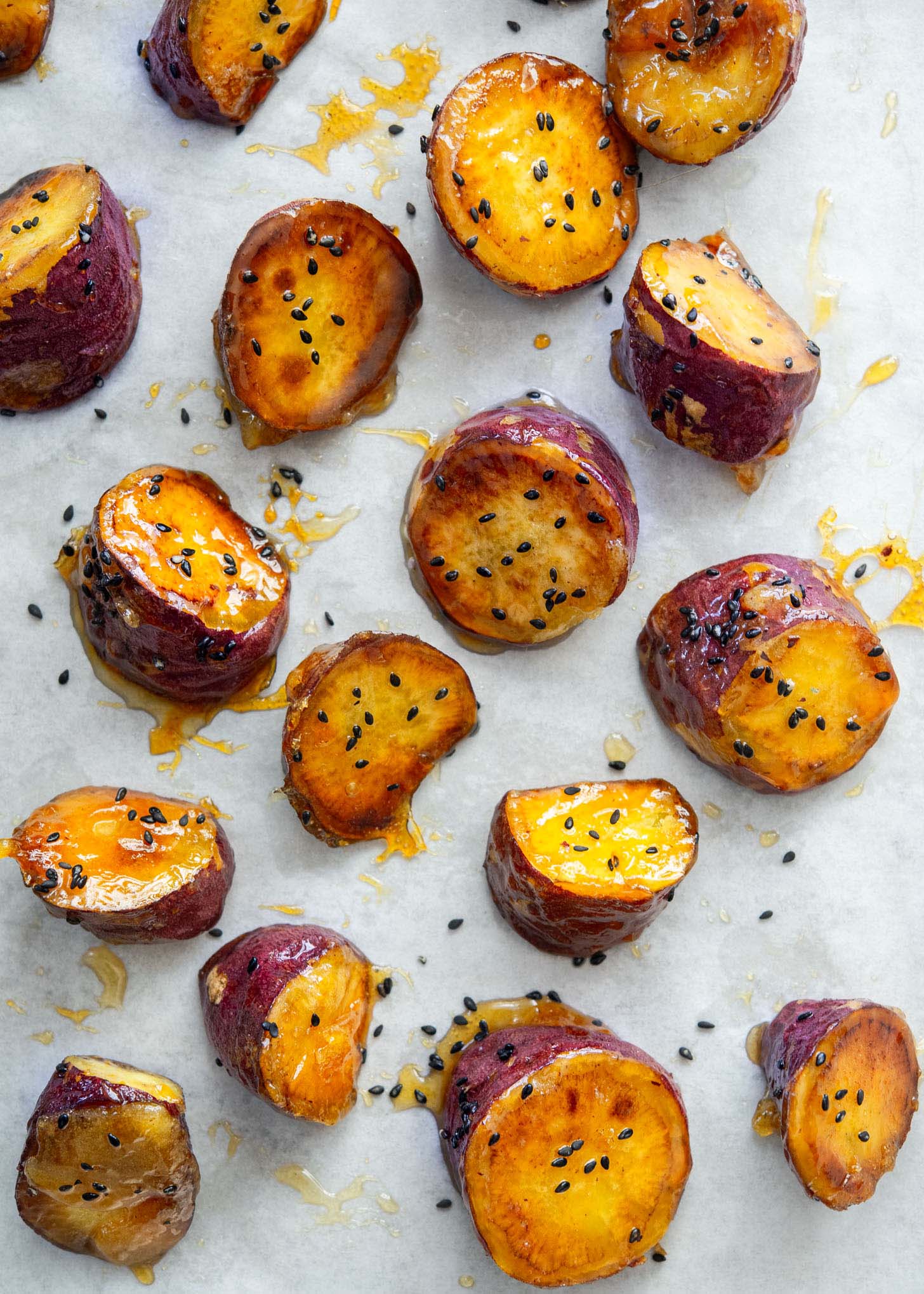
The Korean candied sweet potato, known as goguma mattang (고구마 마탕), is a delicious treat that has been popular for generations. It was a favorite street food of mine growing up, and I still find it in local food shops and markets today.
While distinct from American-style candied yams, Korean sweet potato pieces are deep-fried to a golden brown. They are then coated in glossy, caramelized sugar, creating a hard, candy-like shell that adds a delightful crunch.
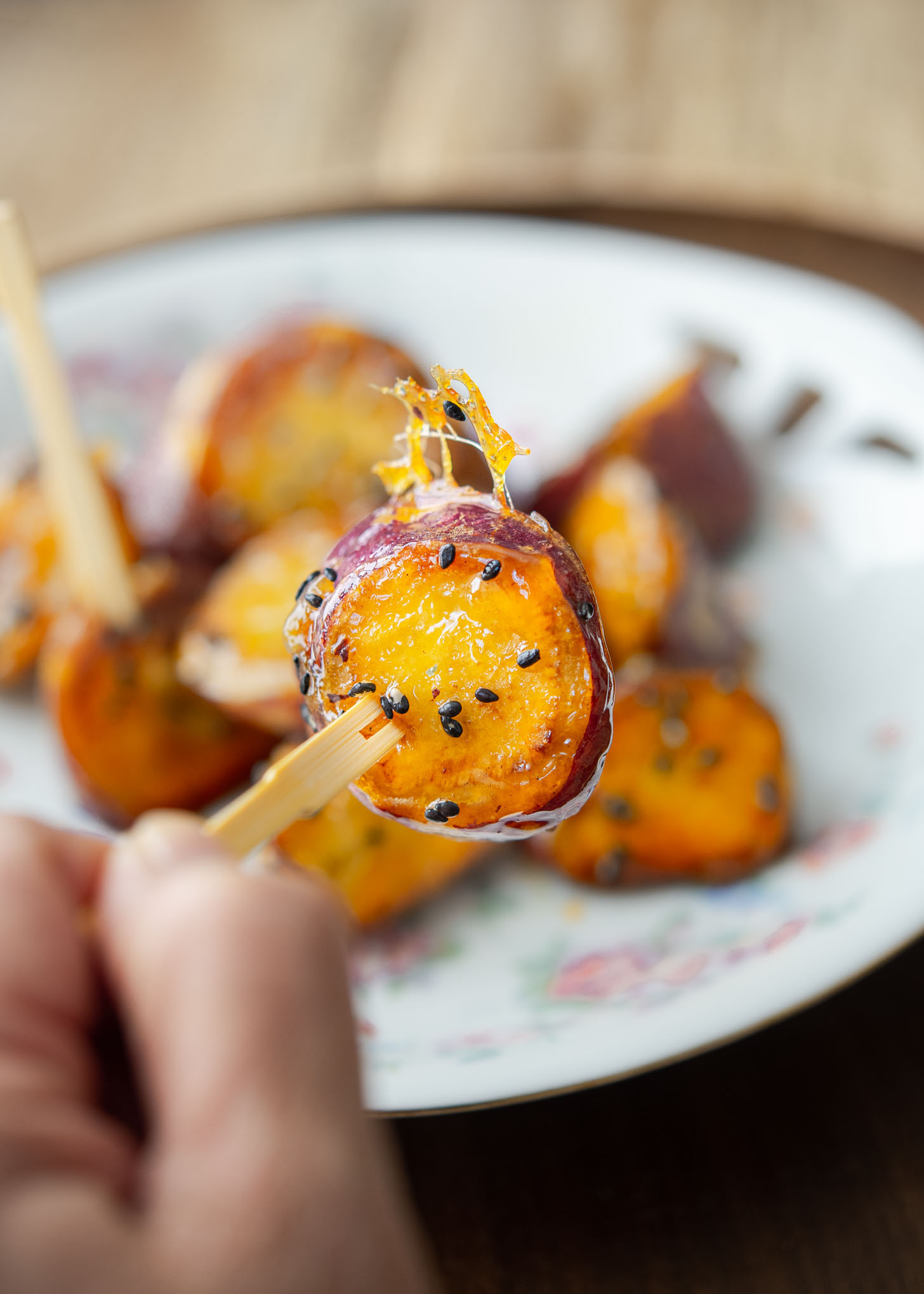
“Mattang (맛탕)” refers to the cooking technique of glazing deep-fried ingredients, such as sweet potatoes (goguma), in caramelized syrup. This creates the crunchy, candy coating that makes this Korean dessert so irresistible.
It’s reminiscent of the Japanese Daigaku Imo but the Korean version stands out with its crunchier, almost brittle-like shell.
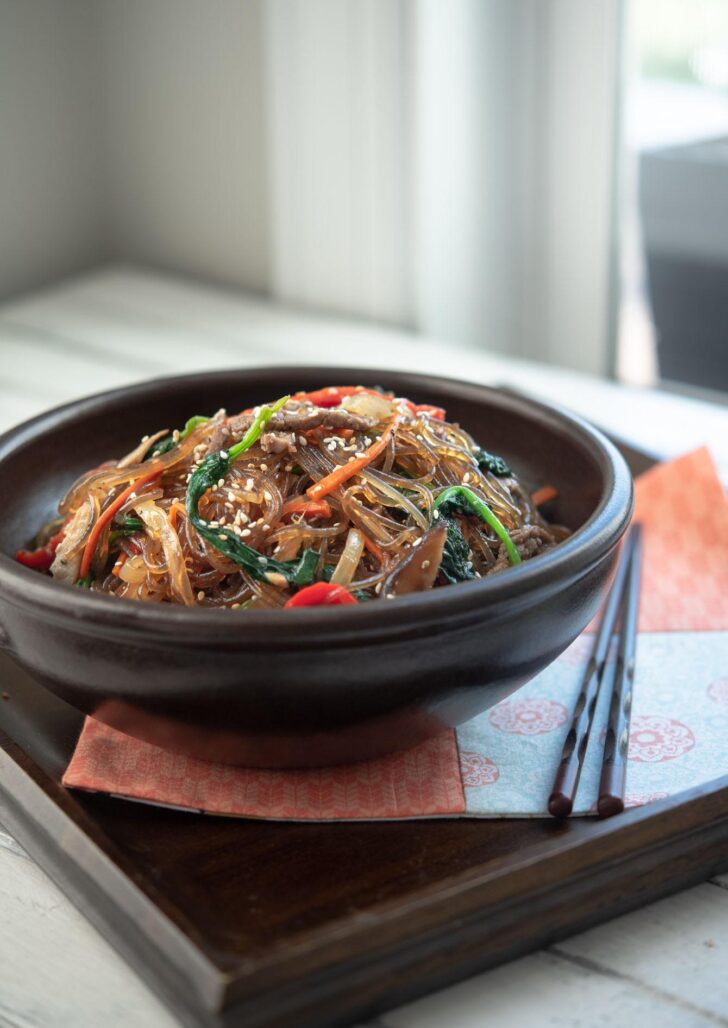
Get new recipes via email:
What are Korean Sweet Potatoes?
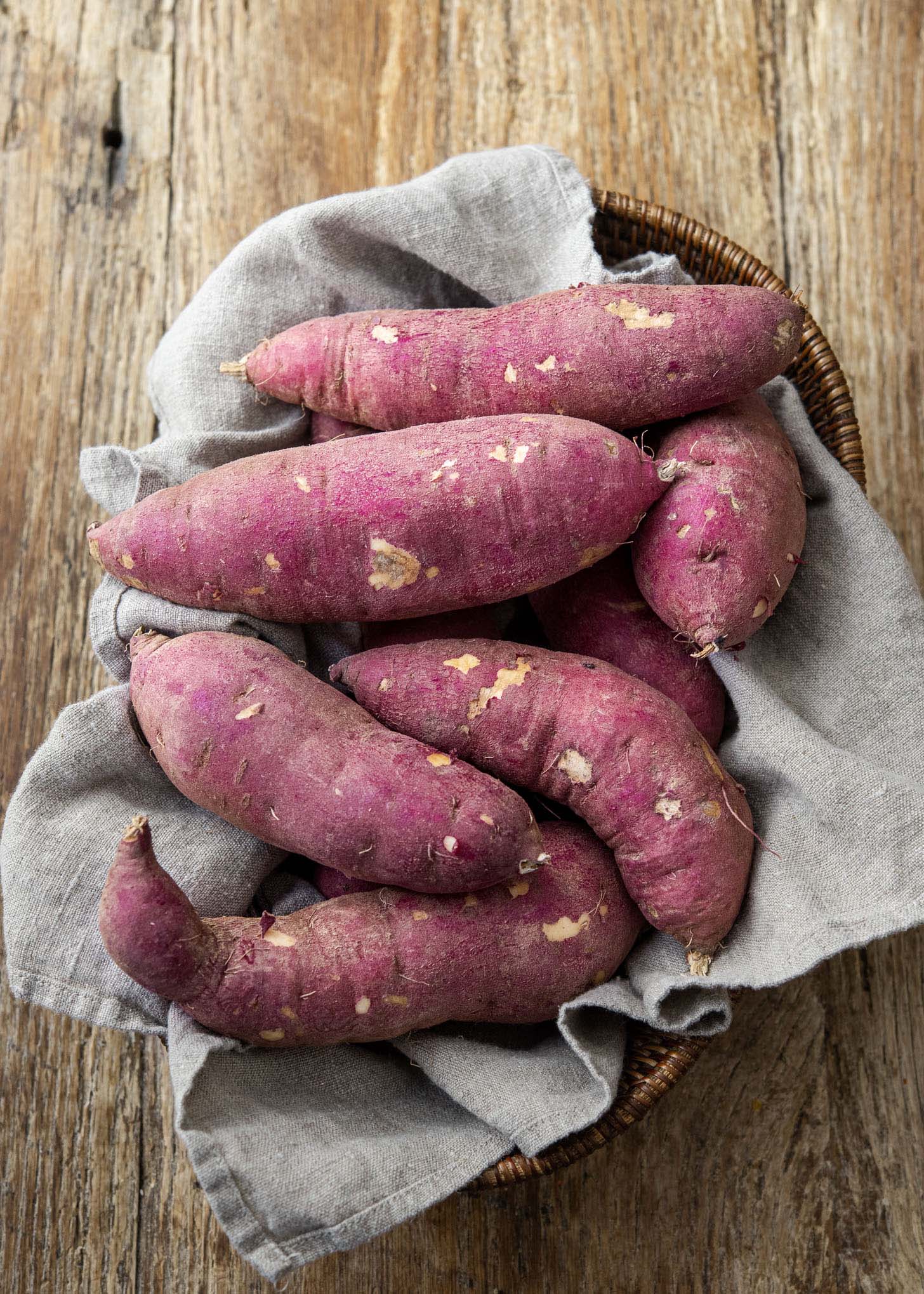
Korean sweet potatoes, known as goguma, are notably different from Western or American sweet potato varieties. They typically have purple skin and yellow or white flesh, setting them apart from the more common orange-fleshed varieties such as yam.
Their taste is uniquely sweet, similar to chestnuts, and they have a firmer texture. In Korean cuisine, these different sweet potatoes are versatile, used in various dishes like steamed, roasted, or as part of sweet snacks. They’re also packed with vitamins and fiber.
Korean and Japanese sweet potatoes are quite similar in both appearance and taste, often making them interchangeable. You can easily find them in Korean grocery stores and Asian markets.
For another delicious experience, try my roasted Korean sweet potato recipe.
Ingredients for Making Goguma Mattang
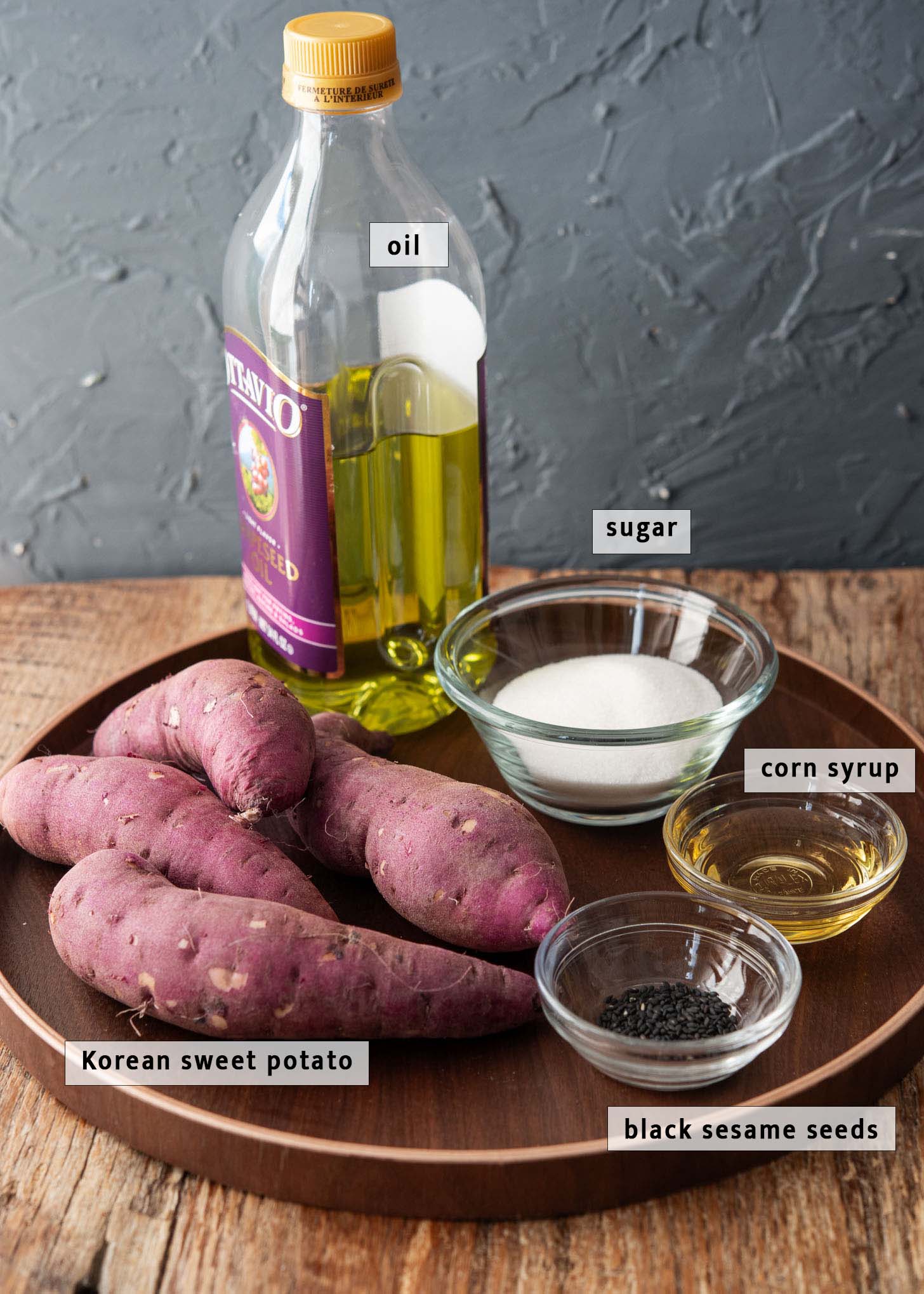
Korean or Japanese Sweet Potatoes (Goguma): Select those with deep purple skin. Choose evenly sized potatoes to ensure they cook uniformly.
Vegetable Oil: Needed for deep frying. Use any non-fragrant oil with a high smoke point.
Sugar: Use plain white granulated sugar, which is ideal for creating the hard caramel coating.
Black Sesame Seeds: These are optional for garnishing. They add a nice contrast to the golden coating.
Success Tips for Candying Sweet Potatoes
- When washing the sweet potatoes to remove dirt, make sure they are completely dry before frying. This prevents oil splatter.
- Peeling the skin is a matter of personal preference.
- Cut the sweet potatoes into even-sized wedges at an angle, creating different shapes for crisper edges.
- To achieve angled cuts, rotate the sweet potato while slicing.
- For the caramel coating, sprinkle sugar into the oil and wait for it to start melting and forming golden bubbles in the center before stirring. Swirl the pan gently to allow the caramel to turn a golden brown color.
- Adding a little corn syrup towards the end of caramelizing sugar can slow down the hardening process, but still creates hard crunchy shell.
- After frying, place the sweet potato pieces on parchment paper and quickly sprinkle black sesame seeds on top before the candy coating hardens.
How to make Korean Candied Sweet Potato
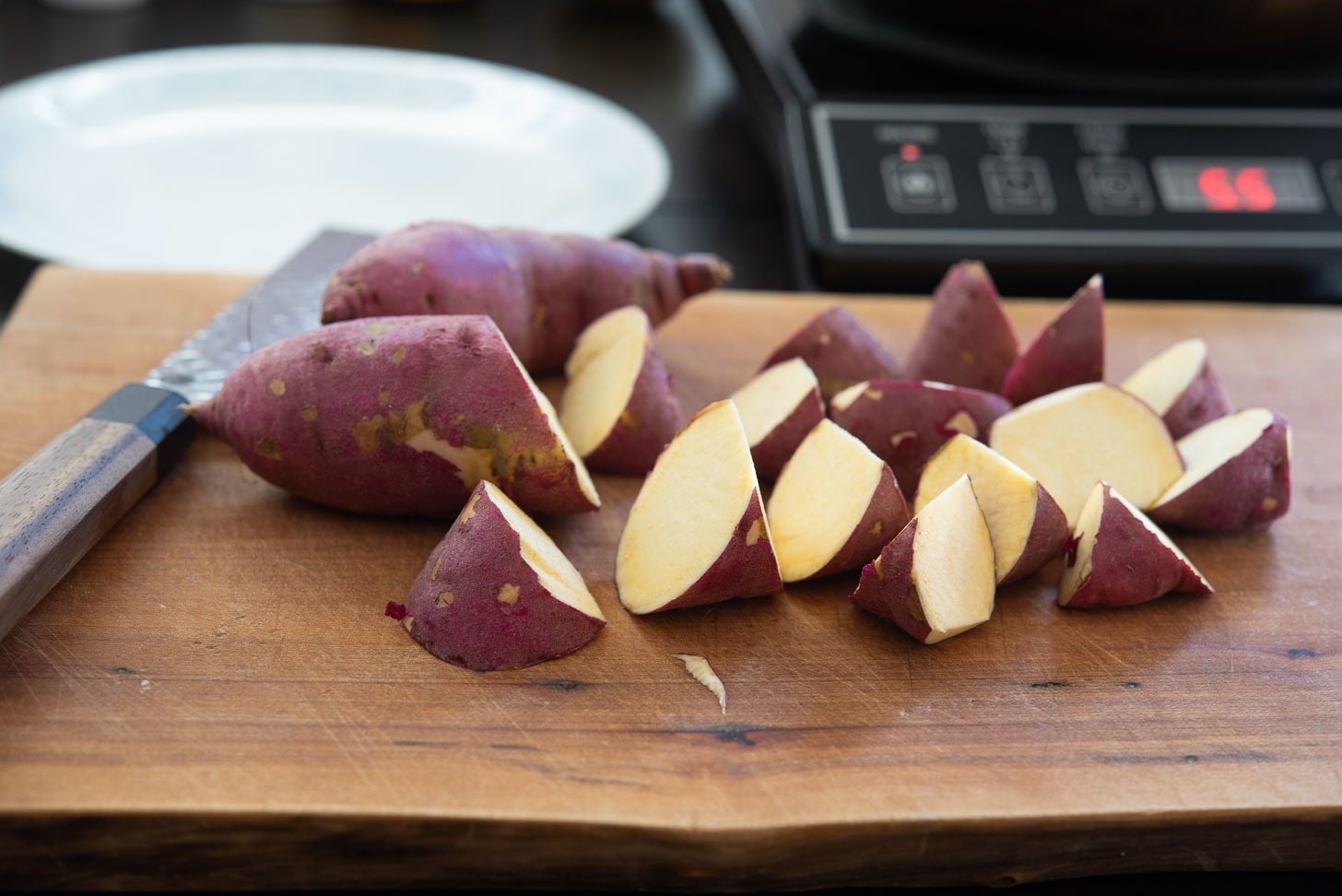
Preparing the Sweet Potatoes
- Dry the sweet potatoes with a paper towel and cut them into evenly sized, angled wedges.
- Prepare a large baking sheet lined with parchment paper or a silicone mat.
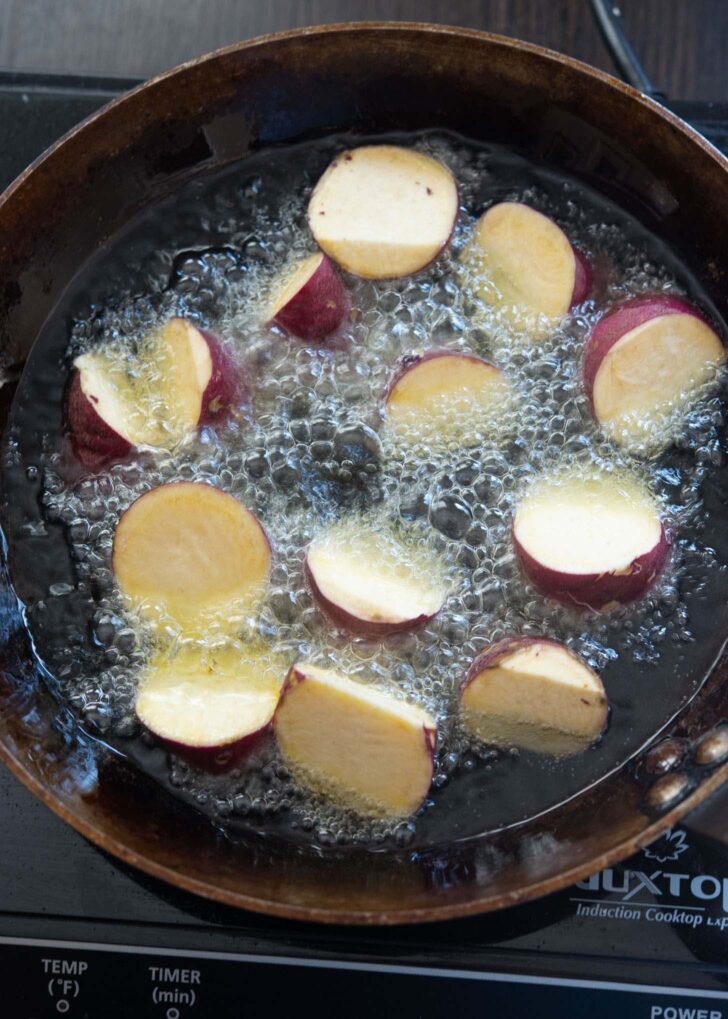

Deep Frying
- Heat about 1 inch of oil in a pan over medium heat for deep frying. The ideal temperature is 350˚F (175˚C), which you can check with a candy thermometer.
- Fry the sweet potato wedges until golden brown, ensuring to turn them for even cooking. Avoid overcrowding the pan and fry in batches if necessary.
- After frying, shake off excess oil and transfer the wedges to a wire rack or paper towel-lined baking sheet. Reserve 1 tablespoon of the oil and Discard the rest oil.
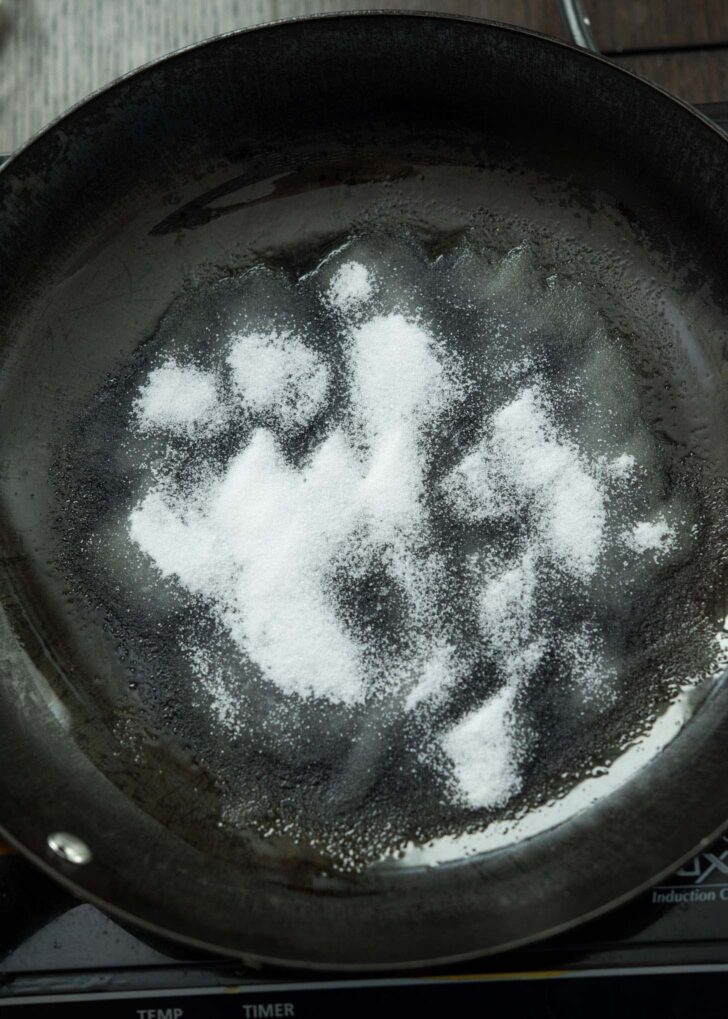
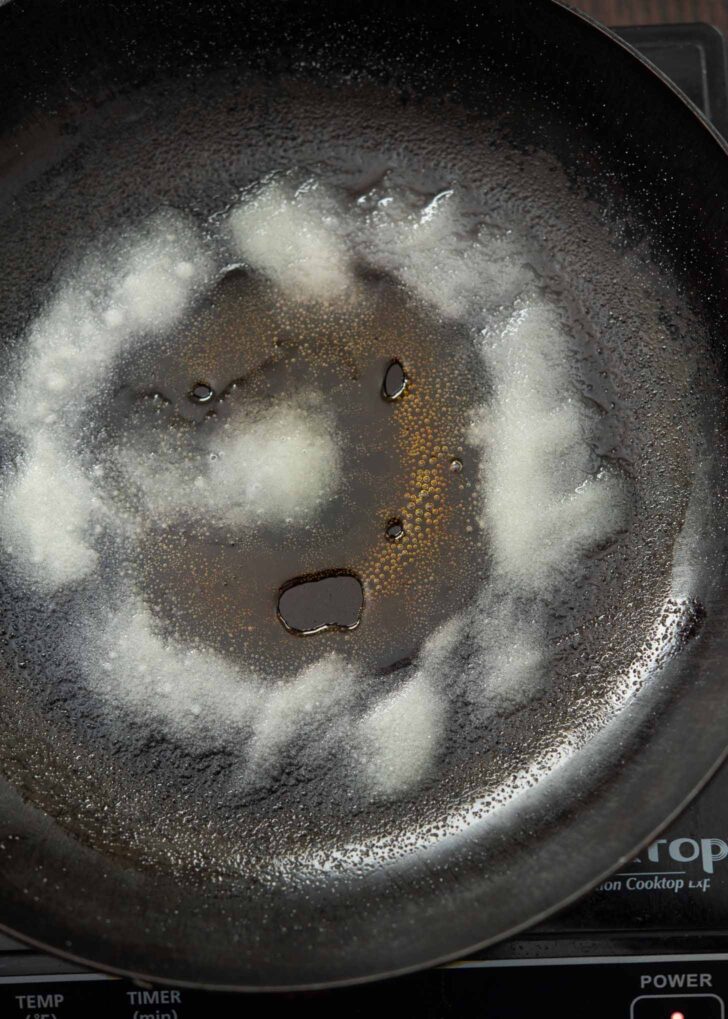
Making the Caramel Sauce
- In a large skillet over medium low heat, add 1 tablespoon of the oil used for frying. Scatter sugar around and allow it to melt without stirring.
- Once golden brown bubble appears, gently shake the pan to evenly caramelize the sugar.
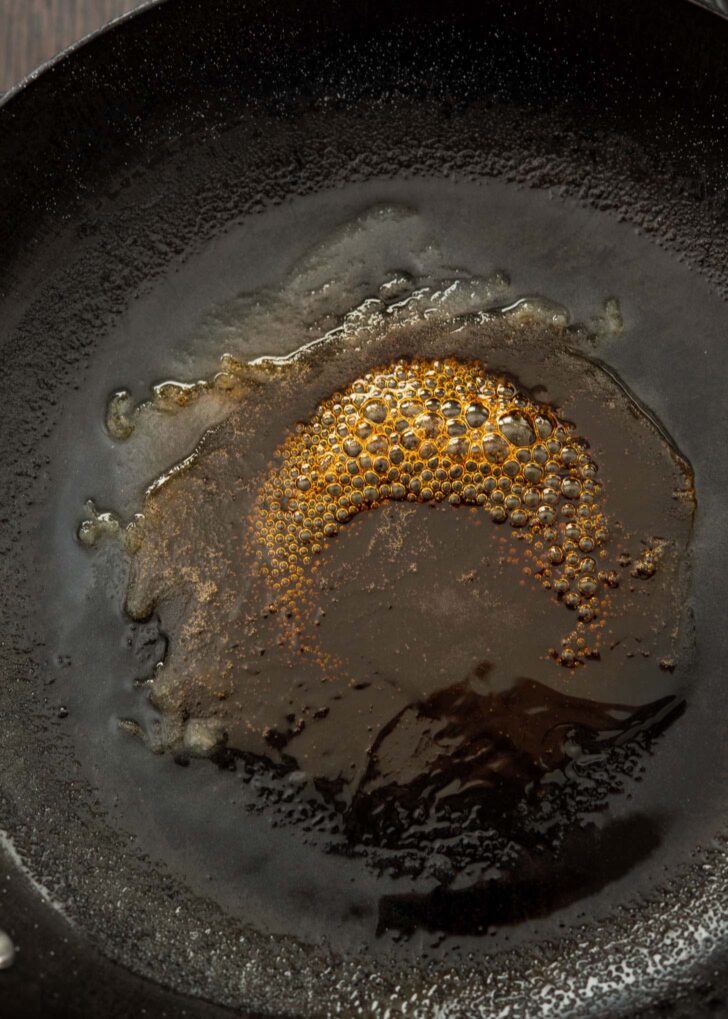
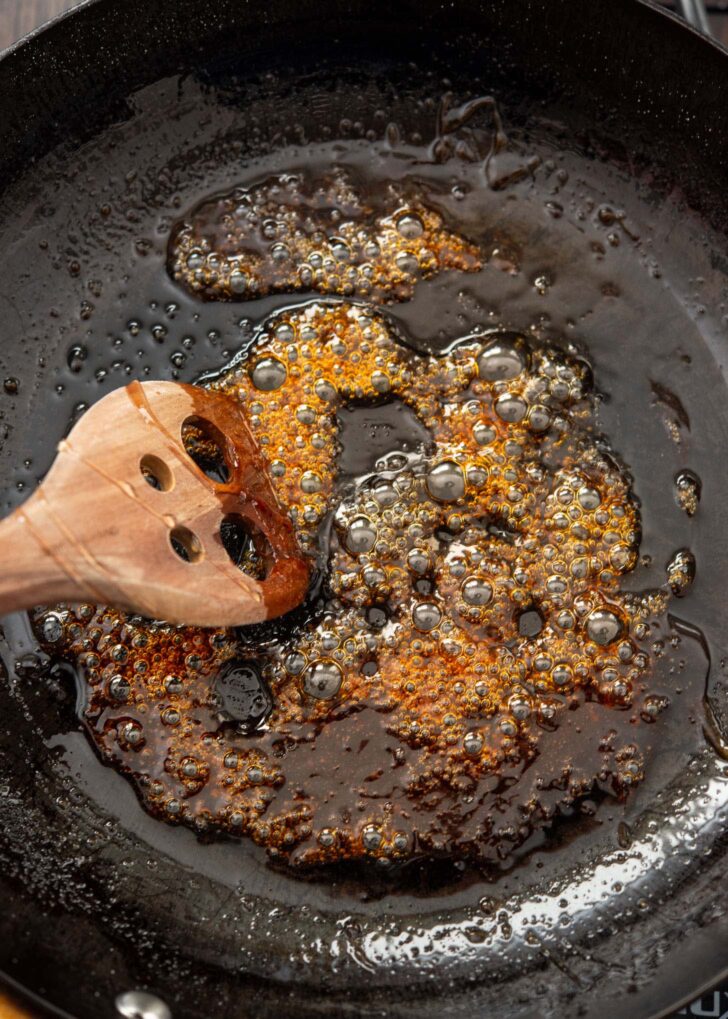
- When most of the sugar has caramelized, add corn syrup and let it bubble for a moment.
- Stir the caramel sauce cautiously to prevent it from burning.
Note: Be careful with the caramel to avoid burning, as burnt caramel can taste bitter.
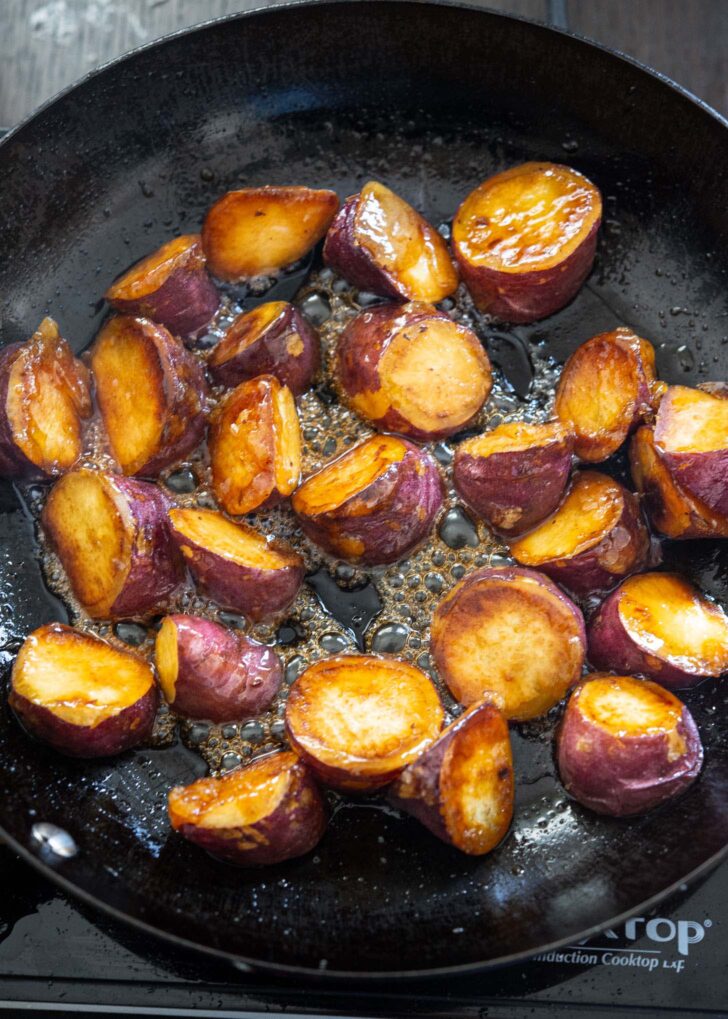
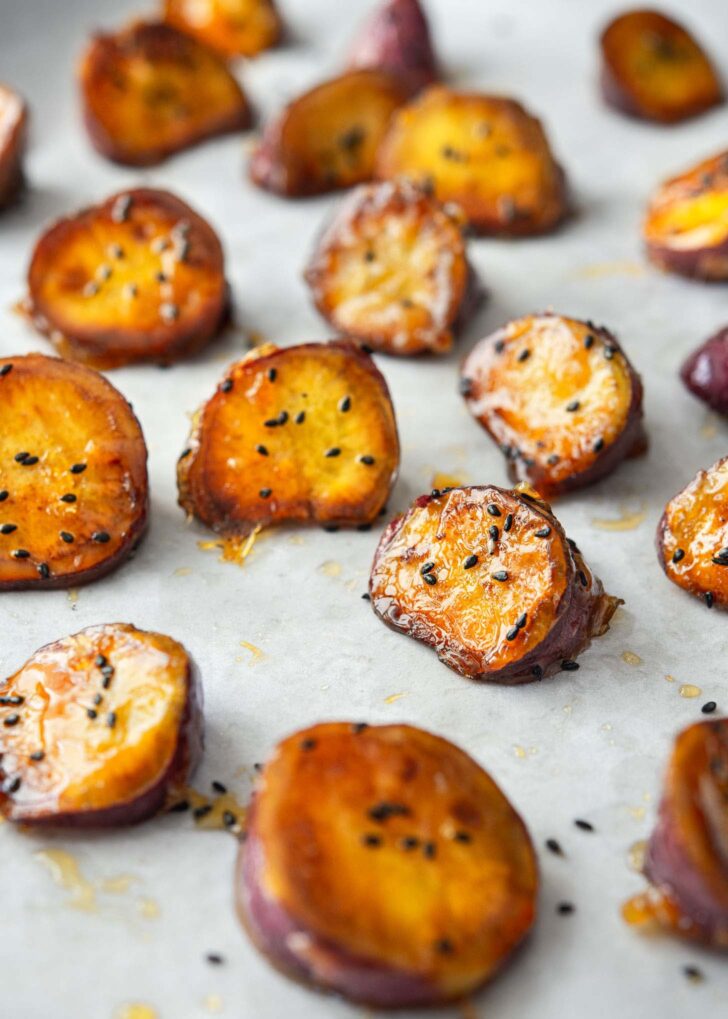
Coating and Garnishing
- Immediately add the fried sweet potatoes and a pinch of salt to the caramel sauce. Toss to coat each piece evenly.
- Lay the candied sweet potatoes on the parchment lined baking sheet, ensuring they don’t touch. If using, sprinkle black sesame seeds for garnish before the caramel hardens.
- Allow them to cool completely before serving.
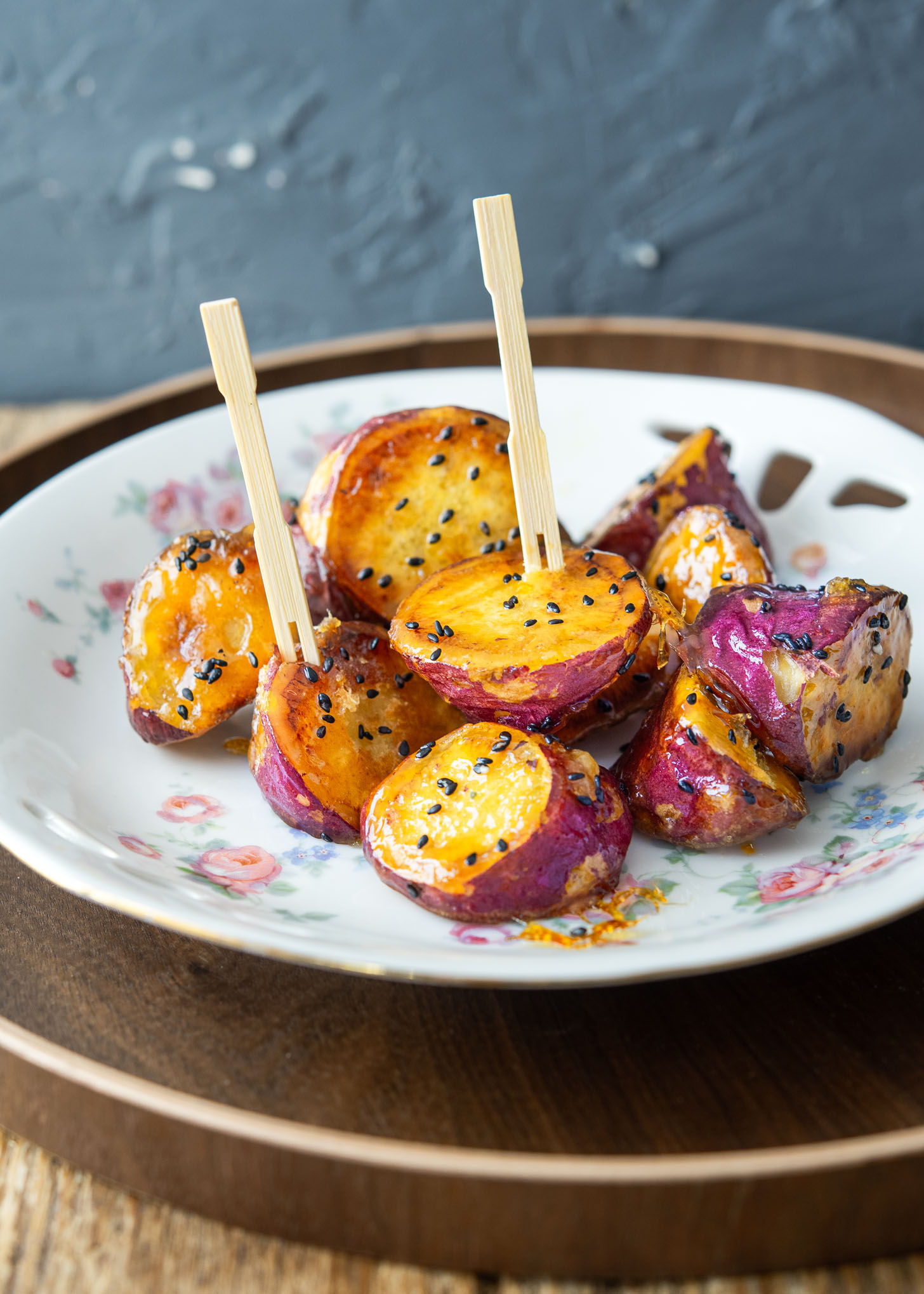
Storage Suggestion
Goguma mattang is most enjoyable when eaten fresh. If you have leftovers, store them in an airtight container in the fridge.
Keep in mind that the hard candy shell will soften over time, turning into a sweet syrup, so it won’t retain its original crunchiness. However, it will still be delicious!
Related Recipes
- Hotteok (Korean Sweet Pancake)
- Korean Twisted Donut (Kkwabaegi)
- NYT Gochujang Caramel Cookies
- Bungeoppang (Korean Fish-Shaped Taiyaki Bread)
- Injeolmi (Quick Korean Rice Cake Dessert)
Love this recipe? Rate it and share your experience in the comments below! On Instagram? Tag me to showcase your creation. For more delicious recipes, subscribe to our newsletter!
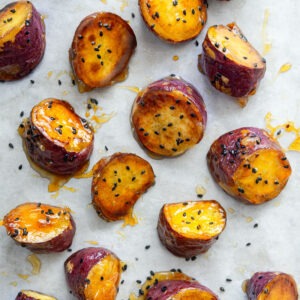
Crunchy Korean Candied Sweet Potato (Goguma Mattang)
Ingredients
- 1 lb (450 g) Korean sweet potatoes
- oil, for deep frying
For caramel sauce
- 1 tbsp oil
- 4 tbsp white sugar
- 1 1/2 tbsp corn syrup
- 1 pinch salt
- 1 tsp black sesame seeds, for garnish, optional
Equipment
Instructions
- Dry the sweet potatoes with a paper towel and cut them into evenly sized, angled wedges. Prepare a large baking sheet lined with parchment paper or a silicone mat.
- Pour about 1 inch of oil in a pan and heat over medium heat for deep frying. Aim for 350˚F (175˚C), using a candy thermometer for accuracy. Fry the sweet potato wedges until golden brown, turning them for even cooking. Don't overcrowd the pan and fry in batches if needed. After frying, remove excess oil and place the wedges on a wire rack or paper towel-lined baking sheet.
- To make the caramel sauce, put 1 tablespoon of the used frying oil in a large skillet over medium low heat. Scatter the sugar and let it melt without stirring. When golden brown bubble appears, turn down the heat to low and gently shake the pan to evenly caramelize the sugar. Stir carefully to avoid burning as the syrup turns dark brown quickly. Add corn syrup to the caramelized sugar, allowing it to bubble briefly as you stir.(Note: Watch the caramel closely to prevent burning, as it can turn bitter quickly.)
- Add the fried sweet potatoes and a pinch of salt to the caramel. Toss to coat each piece evenly.
- Arrange the candied pieces on the prepared parchment lined baking sheet, keeping them separate. If desired, quickly garnish with black sesame seeds before the caramel sets. Let them cool completely before serving.
Notes
- Goguma mattang tastes best when it’s fresh. For any leftovers, place them in an airtight container and refrigerate. The hard candy shell may soften and become more like a sweet syrup, losing its crunch, but it will remain tasty
- Remember to handle the caramel coating with caution as it gets very hot.

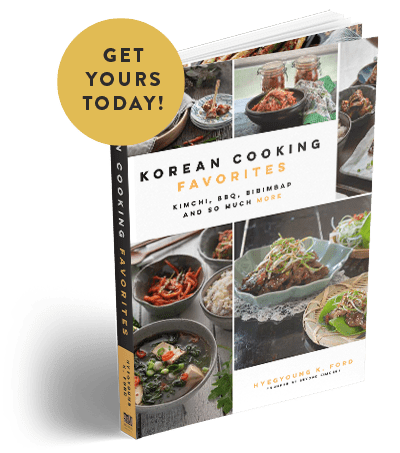
I would be afraid it would stick without oil. I’ll give it a shot though. This looks scrumptious.
thank you for sharing this wonderful recipe….i love caramel and sweet potatoe..this must taste delicious…im gonna try it!
http://thestoryofayna.blogspot.com/
Wow great looking dish, I love sweet potato anyway, but think I need to give this a go 🙂
my mom used to fry the sweet potato first in oil and then coated them in sugar/water mixture. would I need a good/thick non-stick pan for the sweet potato to cook completely through? I only have a mediocre quality non-stick pan…
Hi Jiji, you will need to use non-stick surface pan so that sugar caramel won’t stick to the pan too much.
Hi Holly unni,
I followed your recipe and it came out just perfect! I used a little oil though just to make it taste unhealthy as it originally is. lol.
I didn’t have an orange or a zester, so I sliced a thin layer of cutie mandarin orange peel instead. It was amazing!
I also threw in a dot of salt for flavor.
I highly recommend this recipe to all!
Hi Jiji, I am so glad to hear that you like the sweet potatoes. I think adding a little salt will enhance the flavor nicely. Thanks for your comment. Have a great Thanksgiving!
Great looking dish! I use sweet potatoes all the time, but not like this – I’ll definitely need to give this a try. I like adding spicy flavorings to sweet potatoes (they’re wonderful in chili, for example). Your kids might like them better that way. Anyway, good stuff – thanks.
Oh thank you for another wonderful recipe. I will def. try this one since my daughter and mother love sweet potatoes. I will let you know their verdict. 🙂
Do you use a certain kind of sweet potatoes? Japanese or the kind you find in the southern US?
HI Irene, I used Japanese sweet potatoes.